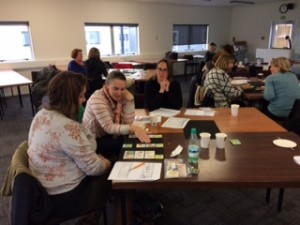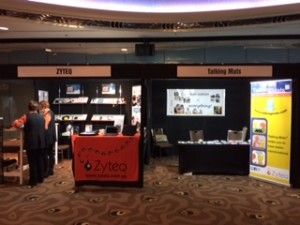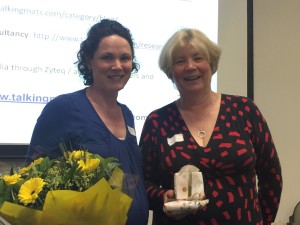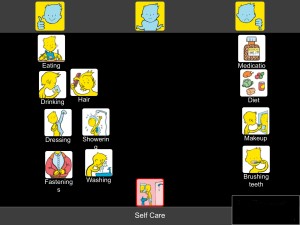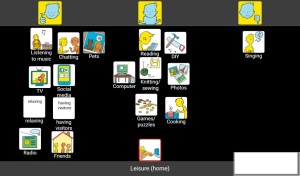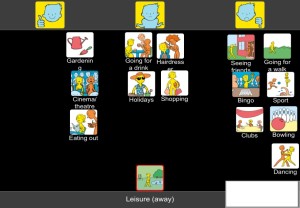Involving people with a learning disability in service evaluation is both essential and challenging.
Maria Lavery speech and language therapist, and her colleagues in North and South Lanarkshire are using Talking Mats to get feedback about the service they deliver for people with a learning disability . They want to find out about what people feel they do well, and what could be done differently. In addition they have placed a suggestion box at the entrance to their building, but want to involve everyone who is connected with their service – clients, family, carers various multi-agency colleagues and are carrying the review out over a 6 month period.
The analysis and learning will be used to inform the Speech & Language Therapy work plan and support the future direction of the service.
Talking Mats has been used successfully to evaluate Augmentative and Alternative Communication services and the resource for this is available on our website http://www.talkingmats.com/wp-content/uploads/2013/09/AAC-service-Evaluation-script-and-symbols.pdf
We are currently working to develop a Talking Mats resource to support conversations relating to Advance Care Planning (ACP) with staff and patients from Strathcarron Hospice. People who use hospices often have specific difficulties communicating their thoughts and feelings because of advanced illness and emotional factors.
Sixteen staff from the multidisciplinary team at Strathcarron Hospice were trained to use Talking Mats by Sally Boa who is Head of Education, Research and Practice Development at Strathcarron Hospice and also one of our accredited trainers.The staff trained used it successfully with patients in the hospice and found that they could use it with a range of patients for a variety of purposes: getting to know someone; identifying goals; discharge planning.
A sub-group of staff attended a workshop with members of the Talking Mats team to discuss the potential use of Talking Mats to support conversations relating to ACP. Topics and options were agreed. These were then presented to a wider forum of staff from Highland Hospice for validation and checking. Three main topics to support ACP conversations were identified: Affairs; Care and Personal Values. New symbols are being developed and the resource will be trialled with a range of patients in the hospice setting.
Our hope is that Talking Mats can be used by trained staff in a hospice setting to support people to express their views and help them plan for the end of life and that it will also be helpful for many other people to consider future options in their lives.
We will write an update once the new resource has been completed.
Laura Holmes was pleased to meet up with Rachel Clemow, Head Teacher and Donna Wood, Education Support Worker who work for the Virtual Schools Team in Wigan to find out about the impact of Talking Mats training.
Donna accessed a Talking Mats Training last year delivered by a Talking Mats accredited Trainer in Wigan Educational Psychology service and quickly put her training into practice with the children that she works with, using the Consulting Children and Young People – Primary resource pack. Other members of the team soon recognised the potential benefits of introducing this approach themselves, and so, in April 2017, a further 15 members of the Virtual Schools Team received Talking Mats training.
Looked After Children can often struggle to express their thoughts and feelings, often as a result of their situation/ circumstances. This can be further compounded if they also present with speech, language and communication difficulties. There is a higher risk of such difficulties within the LAC population (Cross 1999 ).
Often there are many professionals involved with a Looked After Child, all asking a wide variety of questions, some of which can be highly personal and/or emotive in nature. The team have observed that children will sometimes end up giving answers which they think the listener wants to hear, rather than answers which reflect their true feelings/views – or the child may withdraw from the process entirely. Consequently, it can be very difficult to ensure that the true ‘voice of the child’ is being heard. Sometimes the children themselves struggle to understand what their own feelings are – often the topics and questions can be complex and involve abstract concepts.
Rachel and Donna report that the Talking Mats approach has had a big impact on their communication style when working with the children on their caseloads, and has enabled children to express their thoughts and views in a safe, neutral environment. Some of the comments they made about Talking Mats were that it:
– Enables the listener to get to know a child quicker and more easily as there is no pressure/expectation of the ‘thinker’ – it is a child/’thinker’ led approach.
– Provides way of supporting the child to open up to express their views and feelings, even if they have previously been hard to engage – and for the child to develop better insight into their own feelings.
– Helps to avoid the possibility of adult/listener misinterpretation of what the child is trying to communicate.
– Enables the child to focus on pictures – which appears to result in the child being more comfortable in expressing their own views and feelings – as opposed to what the child thinks the listener wants to hear.
– Provides a holistic view of the child – which can support target setting and planning at key stages for that child, for example, transition to High School.
– Gives the child something they can be successful at – there are no ‘wrong’ answers.
Donna shared a great example of how Talking Mats helped a young girl to describe an issue at home which she had not shared with any carers or school staff previously. The child placed the ‘home’ option symbol on the ‘not happy’ section of the mat then began to whisper to Donna explaining the reason why. This resulted in Donna being able to share the information with school staff and social care, consequently, the issue was resolved.
Services, organisations and schools in Wigan are already using the Talking Mats approach as a result of widespread training delivered by our Accredited trainers in the Educational Psychology Team. This provides a great example of how using Talking Mats across agencies can really help a whole area to become more child/ young person led.
The Virtual Schools team are now recommending the Talking Mats approach to other agencies working with the Looked After Children on their caseloads, such as adoption and fostering services.
If want to access the training then there are Talking Mats foundation courses run regularly in London, Stirling , Manchester and Newcastle . Once you have attended a foundation training and gained experience you can apply to become an accredited trainer .
This is the second blog about Lois and Nicki’s amazing visit to Australasia – this time theirTalking Mats trip to New Zealand.
The view flying into New Zealand was dramatic. We looked down on a beautiful range of snow topped mountains glistening in the clear blue sky as our plane flew towards Christchurch. Our first stop was the South island for a foundation training organised by Talk Link. Our second foundation training was in Auckland in the North Island. At both places we had a fantastic group of interested practitioners who really engaged with how Talking Mats could be used and began thinking creatively about how they would apply in their work place .This included:
• Involving thinkers in decisions about the their alternative and augmentative communication and getting feedback on what works for them
• Exploring its value for young people in the youth justice system to support them to express their views and be a tool for increasing engagement
• Exploring how Talking Mats could be adapted to make them more accessible and culturally accepted to the Maori community
• Involving children in their education planning
We were really pleased that Talk Link also sent 3 staff to the accredited training course in Australia. This means that there will be increased access to Talking Mats Foundation training in New Zealand for the future. Our experience is that accredited trainers provide leadership that helps organisations embed Talking Mats into practice. Thanks to Ann Smaill for all her organising and support for both our Foundation and Accredited courses.
And our leisure times were special too. We had a trip on the Christchurch Gondola to see the stunning Banks peninsula; we experienced the hope and resilience of Christchurch following the earthquakes in 2010 and 2011. In Auckland we saw a thought provoking Maori exhibition and last but not least we loved our weekend of rest and relaxation on the very special island of Waiheke. The locals thought us mad to swim in the sea their autumn but we loved it!
More information
Click for more information if you want to find out about
It was a great privilege for Nicki and Lois to visit to Australia and New Zealand and share our experience of Talking Mats with such a fantastic group of interested people. We learned a lot about the opportunities and challenges their work settings present. Our first blog focuses on Australia and the second on New Zealand.
Australia
Agosci
We had just over two weeks in Australia. During that time we attended and presented at the Agosci conference – a great gathering of practitioners from all over Australia and further afield who are focused in improving practice in Alternative and Augmentative communication. There was a lot of interest in Talking Mats – our stall was busy and our preconference workshop full.
A key driver for the interest was the implementation of the National Disability Insurance Scheme (NDIS) which is changing the way the individual packages of care are being administered with the need to establish what is important to the person and their life goals. Talking Mats is recognised as a great tool to help that happen and although there did not appear to be any NDIS planners at the conference we are hopeful with the buzz that was created the message will get out.
Dementia
It was interesting for us to see that at Agosci there was no mention of the role augmentative and alternative communication could play in terms of supporting communication with people with dementia. It is true that in the UK equivalent conference ‘Communication Matters’, the use of AAC in dementia is not the strongest theme but you will still find discussion and papers about it. It felt to us the world of AAC and dementia was still very separate in Australia and closing that gap could provide an enhanced quality of life for people with dementia.
We appreciated being invited to deliver training for Hammond Care in Sydney. They were an experienced group of practitioners and we had interesting discussions about using Talking Mats in their work with people with dementia.
We are excited too that one of our new Australian accredited trainer, Lyn Philipson will be using Talking Mats in her research with people with dementia.
Keeping Safe
Our new ‘Keeping Safe’ resource sparked a great deal of interest. Naomi Rezzani of Scope Australia organised a seminar which Lois was invited to speak at.
It was good to hear about the local initiatives in the state of Victoria to support people with learning disabilities who have experienced or are at risk of abuse . The presentations discussed the role of advocacy, therapeutic support, education about rights, the Scope ‘Speaking Out’ resources that support communication. The countries may be different but themes are similar.
Accredited training and Zytec
At the end of our stay we held an accredited training course and are delighted that 9 Australians and and 3 New Zealanders can now provide training in their respective organisations.
Throughout our visit we were very well supported by our Australian Partner Zyteq and being able to work closely with them for two weeks has strengthened our partnership. We are delighted that Tracey Bode and Karyn Muscat of Zyteq will continue promoting Talking Mats in Australia. They are the Australian providers of face to face training and the original Talking Mats resources
Time off!
It was of course not all work. We loved seeing for real the iconic images of Sydney opera house the harbour bridge , bronzed bodies surfing in the sea , Melbourne with its myriad of art deco buildings , graffiti street art and the cute wee St Kilda fairy penguins. So lots of happy memoires and hopes we will be back.
More information
Click for more information if you want to find out about
Five short stories from our recent accredited training course in Stirling.
- A looked after child was unhappy but no one knew specifically why. Using the Talking Mats, she indicated that she was upset by the weekly phone call with her mother because it always happened when it was her playing time. The time of the call was moved to just before her bedtime but this resulted in bad dreams. The time of the call was finally moved to Saturday afternoon which helped her settle and reduced her distress.
- Talking Mats was used with an Iraqi boy who had come to England via Libya, Italy and the jungle camp at Calais. When he picked the symbol of a waiting room he indicated that despite all she had been through he really liked this because it reminded him of all the children in his family and made him happy.
- A 76-year-old man with a learning disability disclosed that he had been attacked and suffocated by his upstairs neighbour one week previously. It was only when he used the Talking Mats that he disclosed to anyone what had happened.
- A lecturer usually used quantifying measuring with her students to find out how they were managing their studies. Instead she used Talking Mats to find out how they were coping with their work life balance. One student told her that she was managing fine except that her pet rabbits always escape under the bed and it takes her a long time to get them back out so she does not let them out very often!
- Talking Mats was used with a man who had had a stroke and had to go into residential care because his family could no longer look after him. They were very worried that he was unhappy with the new care set up. He was able to show with the Talking Mats that he was happy about everything except that he was not given enough time when he went to the toilet. Once the staff realised this they then gave him more time which resolved the situation and reassured his family.
Please send us your Talking Mats stories – we love hearing them.
We’re always amazed to hear from people about the variety of topics they cover using Talking Mats –from how someone is managing their self care or domestic tasks, to arranging a wedding, or thinking about whats important at a funeral.
As a communication tool Talking Mats maximises a person’s capacity to reflect on a topic and express their view. It gives confidence in decision making.
Here are some other topics we’ve heard about recently.
- As a conversation tool in class
- Pupil voice in school improvement plan
- Client contribution to meetings and review day placement
- Respite
- Operations e.g. gastrostomy
- Health
- Postural management
- Where to live
- Childs opinions in relation to GIRFEC
- Respite feedback/choices
- SW assessments
- Choices available within service
- Going somewhere new
- Transitions
- Problem solving ie horse riding, identifying the problem
- Eating and Drinking
- Keeping Safe
- Social Media
What do you want to talk about? There is no limit!
We are now half way through our project, funded by The Health and Social Care ALLIANCE Scotland, whose overall aim is to empower people with a range of long term conditions, with and without additional communication difficulties, to self-manage their own health and well-being by using Digital Talking Mats.
Participants
We have carried out all the initial visits and 16 follow-up visits and participants are sending in their completed mats, choosing whichever topics they want from the digital Health and Well-being resource. At the time of writing this blog we have received 137 completed mats.
We have received very positive feedback with many examples of how people are using the Digital Talking Mats to self-manage.
Here are 3 examples:
One participant with learning disability has diabetes. Through using the Digital Talking Mats she has stopped buying takeaways every night and is now buying M&S ‘Balanced for You’ meals. This is a huge step forward for her as she refused to discuss healthier eating before.
A man with early onset dementia has identified that he used to enjoy singing and has decided for the first time in his life to join a choir. This is not something that had come up in conversation before. Despite the diagnosis of dementia he has realised that he is still keen to try new things.
The wife of a man with severe aphasia said ‘This (Leisure away) has highlighted how few things he can do away from home. We discussed this but can’t see how we can change the situation.’ However at the second visit he used the same mat and indicated that he had been thinking about his mobility and was about to start swimming and a fitness class.
We already have an increased awareness of the meaning of self-management as we observe how participants are using the Digital Talking Mats to think about their situation, state their own views and share them with carers/support workers. We are also noticing that there is a shift in some relationships as the carers/support workers realise that the person with the long term conditions can make decisions and express their own views rather than having decisions made for them.
We are very grateful to Marieke Lindenschot from the Netherlands for this great blog about finding out what activities children like and we look forward to hearing the next stage of her PhD.
For my PhD research in the Netherlands I use Talking Mats as a tool for my interviews with children. The children I interview vary in their communication abilities. Some are able to express their opinions and feelings very well, others are not able to communicate orally. As I was able to purchase the Talking Mats cards without text, I wrote down the words in Dutch in ‘children’s language’ on the cards.
Last week was an exciting week. I conducted the first pilot interviews with a boy of 12 years, a boy of 9 years and a girl of 8 years. They varied in their development. The first interview went great. The child could express which activities he liked, which he disliked and which were ‘so, so’ (in between like and dislike). With Talking Mats he could also tell me with whom he performed the activities and where. It was a fun way to get a lot of information in only 15 minutes! The child and his mother were very enthusiastic. He was able to tell a lot more then he usually does when he is asked about his activities! Unfortunately the other two interviews didn’t produce the same amount of information. The cognitive level of these children seemed too low to use Talking Mats. The boy didn’t understand the top scale ‘like’ and ‘dislike’, whereas the girl didn’t recognize the activities on the cards.
Overall we were very satisfied with these pilot interviews. The goal was to check if the interview guide with Talking Mats ‘worked’ and also to see for which developmental level this way of interviewing is possible. The pilot interviews gave a lot of information on these two goals. I am looking forward to the next interviews as Talking Mats showed to be a very helpful tool in finding out which activities children like.
Please send us any other examples of how you have used Talking Mats.
The Keeping Safe Talking Mat resource provides a structured framework to ask someone ’How’s your life going? It has 3 topics: Your Well-being; Relationships; Thoughts and Feelings
Do you find it difficult discussing feelings with people who have limited understanding?
Do you have limited time to discuss sensitive issues with people?
Do you want to find out any issues which may be slowing recovery or preventing someone moving forward in life?
A cost benefit analysis demonstrated that using the Keeping Safe resource to create a listening space for people to think and share how their lives are going, is cost effective for organisations.
The design of the resource is described in the Tizard Learning Disability Review More Than Pictures TLDR 2017
It has been trialled and tested with people with learning disabilities throughout Scotland, but has also been used effectively with a range of people who find it difficult to discuss their life e.g. Young people with mental health condition.
It has been shown as a helpful way to
- discuss new information (89%),
- discuss and resolve fears (84%)
- support thinking (89%)
This poster gives an overview of the project KS 2nd Poster (click to enlarge)
The Thoughts and Feelings topic uses a different top scale and this resource is best used by people who have completed Talking Mats Foundation Training. If you want to buy it (£55.00 +VAT) contact the office www.talkingmats.com tel. (+44) 01786 479511
 Online training login
Online training login 

